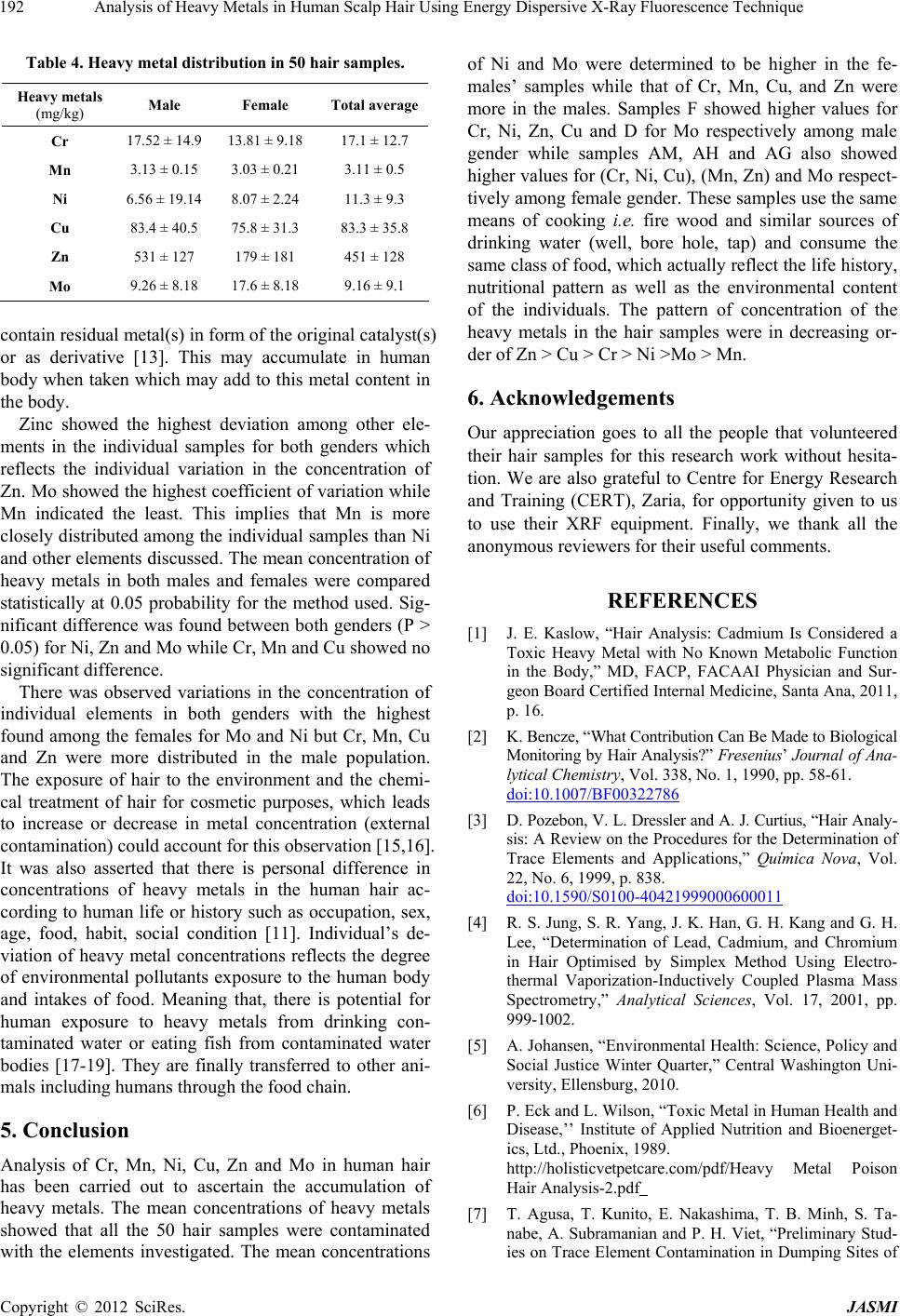
Analysis of Heavy Metals in Human Scalp Hair Using Energy Dispersive X-Ray Fluorescence Technique
192
Table 4. Heavy metal distribution in 50 hair samples.
Heavy metals
(mg/kg) Male Female Total average
Cr 17.52 ± 14.9 13.81 ± 9.18 17.1 ± 12.7
Mn 3.13 ± 0.15 3.03 ± 0.21 3.11 ± 0.5
Ni 6.56 ± 19.14 8.07 ± 2.24 11.3 ± 9.3
Cu 83.4 ± 40.5 75.8 ± 31.3 83.3 ± 35.8
Zn 531 ± 127 179 ± 181 451 ± 128
Mo 9.26 ± 8.18 17.6 ± 8.18 9.16 ± 9.1
contain residual metal(s) in form of the original catalyst(s)
or as derivative [13]. This may accumulate in human
body when taken which may add to this metal content in
the body.
Zinc showed the highest deviation among other ele-
ments in the individual samples for both genders which
reflects the individual variation in the concentration of
Zn. Mo showed the highest coefficient of variation while
Mn indicated the least. This implies that Mn is more
closely distributed among the individual samples than Ni
and other elements discussed. The mean concentration of
heavy metals in both males and females were compared
statistically at 0.05 probability for the method used. Sig-
nificant difference was found between both genders (P >
0.05) for Ni, Zn and Mo while Cr, Mn and Cu showed no
significant difference.
There was observed variations in the concentration of
individual elements in both genders with the highest
found among the females for Mo and Ni but Cr, Mn, Cu
and Zn were more distributed in the male population.
The exposure of hair to the environment and the chemi-
cal treatment of hair for cosmetic purposes, which leads
to increase or decrease in metal concentration (external
contamination) could account for this observation [15,16].
It was also asserted that there is personal difference in
concentrations of heavy metals in the human hair ac-
cording to human life or history such as occupation, sex,
age, food, habit, social condition [11]. Individual’s de-
viation of heavy metal concentrations reflects the degree
of environmental pollutants exposure to the human body
and intakes of food. Meaning that, there is potential for
human exposure to heavy metals from drinking con-
taminated water or eating fish from contaminated water
bodies [17-19]. They are finally transferred to other ani-
mals including humans through the food chain.
5. Conclusion
Analysis of Cr, Mn, Ni, Cu, Zn and Mo in human hair
has been carried out to ascertain the accumulation of
heavy metals. The mean concentrations of heavy metals
showed that all the 50 hair samples were contaminated
with the elements investigated. The mean concentrations
of Ni and Mo were determined to be higher in the fe-
males’ samples while that of Cr, Mn, Cu, and Zn were
more in the males. Samples F showed higher values for
Cr, Ni, Zn, Cu and D for Mo respectively among male
gender while samples AM, AH and AG also showed
higher values for (Cr, Ni, Cu), (Mn, Zn) and Mo respect-
tively among female gender. These samples use the same
means of cooking i.e. fire wood and similar sources of
drinking water (well, bore hole, tap) and consume the
same class of food, which actually reflect the life history,
nutritional pattern as well as the environmental content
of the individuals. The pattern of concentration of the
heavy metals in the hair samples were in decreasing or-
der of Zn > Cu > Cr > Ni >Mo > Mn.
6. Acknowledgements
Our appreciation goes to all the people that volunteered
their hair samples for this research work without hesita-
tion. We are also grateful to Centre for Energy Research
and Training (CERT), Zaria, for opportunity given to us
to use their XRF equipment. Finally, we thank all the
anonymous reviewers for their useful comments.
REFERENCES
[1] J. E. Kaslow, “Hair Analysis: Cadmium Is Considered a
Toxic Heavy Metal with No Known Metabolic Function
in the Body,” MD, FACP, FACAAI Physician and Sur-
geon Board Certified Internal Medicine, Santa Ana, 2011,
p. 16.
[2] K. Bencze, “What Contribution Can Be Made to Biological
Monitoring by Hair Analysis?” Frese nius’ Journal of Ana-
lytical Chem istry, Vol. 338, No. 1, 1990, pp. 58-61.
doi:10.1007/BF00322786
[3] D. Pozebon, V. L. Dressler and A. J. Curtius, “Hair Analy-
sis: A Review on the Procedures for the Determination of
Trace Elements and Applications,” Química Nova, Vol.
22, No. 6, 1999, p. 838.
doi:10.1590/S0100-40421999000600011
[4] R. S. Jung, S. R. Yang, J. K. Han, G. H. Kang and G. H.
Lee, “Determination of Lead, Cadmium, and Chromium
in Hair Optimised by Simplex Method Using Electro-
thermal Vaporization-Inductively Coupled Plasma Mass
Spectrometry,” Analytical Sciences, Vol. 17, 2001, pp.
999-1002.
[5] A. Johansen, “Environmental Health: Science, Policy and
Social Justice Winter Quarter,” Central Washington Uni-
versity, Ellensburg, 2010.
[6] P. Eck and L. Wilson, “Toxic Metal in Human Health and
Disease,’’ Institute of Applied Nutrition and Bioenerget-
ics, Ltd., Phoenix, 1989.
http://holisticvetpetcare.com/pdf/Heavy Metal Poison
Hair Analysis-2.pdf
[7] T. Agusa, T. Kunito, E. Nakashima, T. B. Minh, S. Ta-
nabe, A. Subramanian and P. H. Viet, “Preliminary Stud-
ies on Trace Element Contamination in Dumping Sites of
Copyright © 2012 SciRes. JASMI